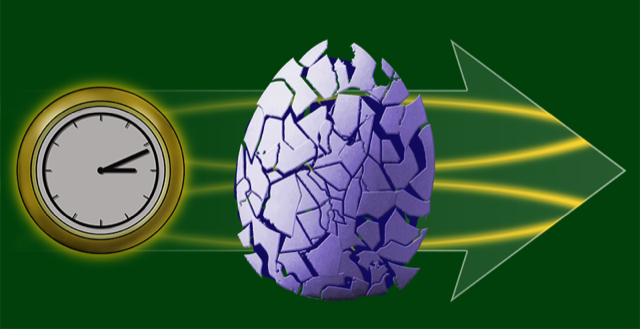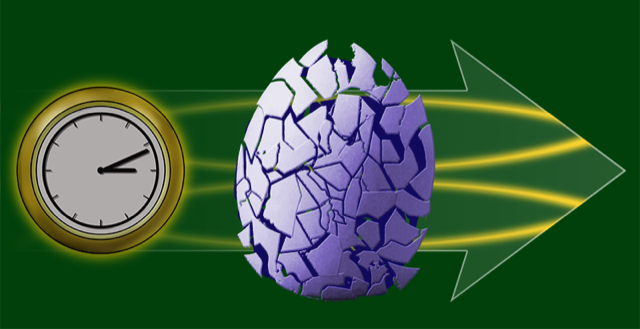Equilibration in Quantum Systems
Human lives revolve around the perception of time, with many of us occupied with fears of growing older or, more mundanely, with looming deadlines. But why does time have a direction at all? Why does it only move forward and never backward? In physics, the answer to these questions lies in the fact that most systems, if left alone, evolve toward a state of equilibrium, in which all fluxes vanish and where the only evidence of dynamics are microscopic fluctuations. In the classical world, this so-called equilibration is well understood. The same cannot be said for the quantum realm. Now, two independent research teams have identified the properties that a quantum system exhibits when it equilibrates [1, 2]. Their results provide an important step in understanding equilibration—and the arrow of time—in quantum systems.
To mathematically describe the equilibration of a classical system, physicists use the notion of entropy [3], a quantity that never decreases in value and that reaches a maximum when the system, for example, vapor, is at equilibrium. When this happens, the trajectories of the particles in the vapor cover its entire volume and the system is termed “ergodic.” An equilibrated system is also chaotic in that it has “forgotten” its initial state. But does a quantum system behave similarly? The notions of chaos and ergodicity are constructs from classical mechanics, which cannot be directly applied to the quantum world, where a particle’s position and momentum cannot be known simultaneously. Quantum systems also have unique behaviors that have no classical counterparts, quantum entanglement being one example. This lack of directly translatable behaviors makes it very hard to determine if, when, and how a quantum system reaches a state of thermal equilibrium. But that difficulty hasn’t stopped physicists from trying.
The first attempt goes back to John von Neumann, generally regarded as the foremost mathematician of his time, who, 90 years ago, formulated the “quantum ergodic hypothesis” [4]. In his theory, entropy monotonically increases in an equilibrating quantum system. We now know, however, that many quantum systems don’t follow this behavior. Even today the problem of equilibration in quantum systems remains unsolved, but three solution routes have emerged. The first flips the problem around by trying to describe classical statistical ensembles using purely quantum effects such as entanglement [5–7]. The second searches equilibrating quantum systems for dynamical quantum features that resemble those found in classical thermalization [8]. Finally, the third route focuses on quantum entropy production to identify which contributions are essential in inducing quantum thermalization [9]. In the new works, Henrik Wilming of the Swiss Federal Institute of Technology (ETH) in Zurich and colleagues at the Free University of Berlin followed the second route, while Krzysztof Ptaszyński of the Polish Academy of Sciences and Massimiliano Esposito of the University of Luxembourg chose the third one.
First, in the work by Wilming and colleagues [1], the team considered an isolated quantum system, whose Hamiltonian has some special symmetries. They then tested out different initial states to find those that corresponded to whether it equilibrated. Previously, physicists had thought that for equilibration to occur in an isolated quantum system, its initial state needed to have a mixture of energy levels. But Wilming and colleagues found that a significantly weaker property is sufficient. Specifically, they showed that a certain type of quantum correlation—one that relates to a specific type of entanglement—has a strong influence on the system’s entropy. In all systems where this correlation was initially present, the system relaxed toward equilibrium. This finding is remarkable, as a much wider range of systems can display these correlations than the “mixture of energy level” requirement suggested, potentially making equilibration more common in quantum systems than previously thought.
Next, looking at the work by Ptaszyński and Esposito [2], the duo studied a different setup in which a small quantum system interacts with a larger thermal bath, a so-called open quantum system. These setups are widely used when studying entropy production. Ptaszyński and Esposito found that they could split entropy production into two fundamentally different contributions. One part came from the buildup of correlations between the system and the bath, a behavior that strongly resembles that found for classical systems. The second contribution is determined by how much the interaction of the quantum system with the bath displaces the bath from its equilibrium state. They find that this contribution oscillates slightly but rarely grows with time. Hence measuring the bath’s displacement from equilibrium allows an estimation of how far the quantum system is from equilibrium.
Despite their different approaches, both works find that the solution to understanding quantum equilibration lies in understanding a quantum system’s entropy. The predictions are also both fully quantum, with neither applying to the classical world. Thus, together, the results provide an important step toward developing an explanation of equilibration in quantum systems.
In the decades since the ideas of quantum physics were first formalized, it has become strikingly apparent that ubiquitous and common classical principles, such as equilibration and the arrow of time, have no simple explanation in a quantum universe. Rather, progress in our understanding of the physical world requires dedicated and thorough investigations of the subtleties and intricacies of quantum systems, which these two new works provide. However, it is like Richard Feynman said, “It doesn’t matter how beautiful your theory is, it doesn’t matter how smart you are. If it doesn’t agree with experiment, it’s wrong” [10]. Thus, experiments are now needed to test the two groups’ predictions, such as whether certain types of entanglement are present in the quantum system’s initial state. Jens Eisert from the Free University of Berlin, who was part of the team working on Ref. [1], and colleagues are already doing exactly that by joining forces with the group of Jörg Schmiedmayer at the Technical University of Vienna, who is a leading figure in experimentally testing explanations of quantum equilibration [11].
So, where does that leave us? Could this improved understanding allow us to one day beat the natural flow of time at the quantum scale? Although we are only just beginning to learn all the ingredients necessary for quantum equilibration to occur, we can be pretty certain that the answer to that question is no and that the direction of time will always remain the same in both the classical and quantum worlds. However, it will be interesting to see if and how the “old” classical arguments fare when they are finally fully translated into a quantum language.
This research is published in Physical Review Letters.
References
- H. Wilming, M. Goihl, I. Roth, and J. Eisert, “Entanglement-ergodic quantum systems equilibrate exponentially well,” Phys. Rev. Lett. 123, 200604 (2019).
- K. Ptaszyński and M. Esposito, “Entropy production in open systems: The predominant role of intraenvironment correlations,” Phys. Rev. Lett. 123, 200603 (2019).
- R. Clausius, “Ueber eine veränderte Form des zweiten Hauptsatzes der mechanischen Wärmetheorie,” Ann. Phys. Chem. 169, 481 (1854).
- J. von Neumann, Mathematical Foundations of Quantum Mechanics (Princeton University Press, Princeton, 2018)[Amazon][WorldCat].
- S. Popescu, A. J. Short, and A. Winter, “Entanglement and the foundations of statistical mechanics,” Nat. Phys. 2, 754 (2006).
- S. Goldstein, J. L. Lebowitz, R. Tumulka, and N. Zanghì, “Canonical typicality,” Phys. Rev. Lett. 96, 050403 (2006).
- S. Deffner and W. H Zurek, “Foundations of statistical mechanics from symmetries of entanglement,” New J. Phys. 18, 063013 (2016).
- J. M. Deutsch, “Eigenstate thermalization hypothesis,” Rep. Prog. Phys. 81, 082001 (2018).
- M. Esposito, K. Lindenberg, and C. Van den Broeck, “Entropy production as correlation between system and reservoir,” New J. Phys. 12, 013013 (2010).
- https://www.youtube.com/watch?v=LIxvQMhttq4.
- T. Langen, R. Geiger, and J. Schmiedmayer, “Ultracold atoms out of equilibrium,” Ann. Rev. Cond. Matt. Phys. 6, 201 (2015).





